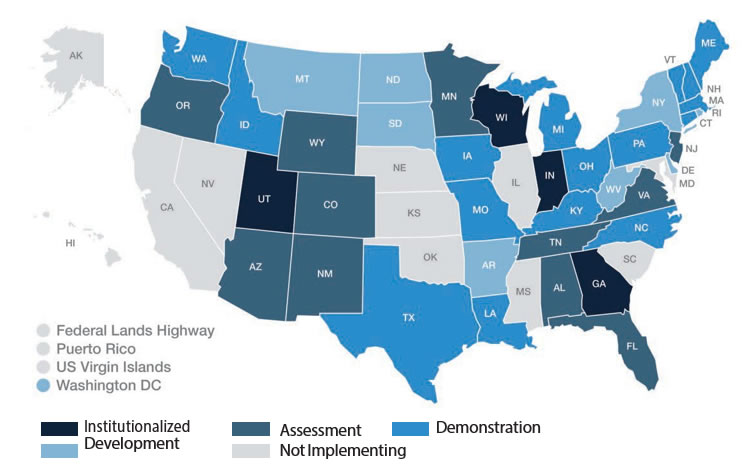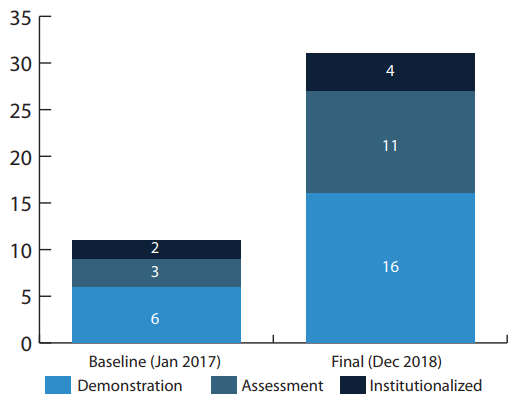Automated Traffic Signal Performance MeasuresAutomated Traffic Signal Performance Measures Before and After Every Day Counts-4 Photo Credit: Adobe Stock
Photo Credit: Adobe Stock
Automated traffic signal performance measures (ATSPM) are fueling a transformation in how transportation agencies approach the management, operations, and maintenance of signalized intersections. The Federal Highway Administration's (FHWA) inclusion of ATSPMs in the fourth round of Every Day Counts (EDC-4) initiative catalyzed the transformation of traffic signal operations from traditional reactive, temporal, and complaint-based approaches to active, objectives- and performance-based approaches. The outcome of shifting traffic signal operations from reactive to proactive results in high-quality traffic signal operations that are consistent with the needs of communities and reflected in operations and maintenance objectives. ATSPMs empower agencies to provide signal operations that are safer, promote greater mobility, reduce congestion, and demonstrate fiscal responsibility.  Photo Credit: Adobe Stock
Photo Credit: Adobe Stock
Deployments and Agency ParticipationPrior to EDC-4, the largest catalyst for ATSPM deployment was the American Association of State Highway and Transportation Officials Innovation Initiative led by the Utah Department of Transportation. It resulted in early ATSPM technology implementation by states and local agencies and established a community of peers ready to share implementation experiences. In Fall 2016, regional EDC summits were held to discuss the selected EDC-4 innovations (including ATSPM) and to find opportunities for implementation. After the summits, State Transportation Innovation Councils (STIC), which bring together public and private stakeholders, met to evaluate innovations and set goals for their deployment. STICs are active in all 50 States, the District of Columbia (DC), Puerto Rico, the U.S. Virgin Islands, and Federal Lands Highway. In January 2017, eleven State departments of transportation had implemented ATSPM to either the demonstration, assessment, or institutionalized levels. The remaining 43 states (whose count included Federal Lands Highway, Puerto Rico, U.S. Virgin Islands, and DC) reported ATSPM in the development stage or were not planning to implement.1  Figure: United States map showing baseline (January 2017) for ATSPM deployment
Figure: United States map showing baseline (January 2017) for ATSPM deploymentSource: EDC-4 Baseline Report, https://www.fhwa.dot.gov/innovation/everydaycounts/reports/edc4_baseline/ At the conclusion of EDC-4 in December 2018, 31 states had achieved their implementation goals of deploying ATSPM on either the demonstration, assessment, or institutionalized levels. The remaining 23 states reported ATSPM in the development stage or were not planning to implement. While the goal of implementation by at least 35 states was not achieved, it is notable that during this two-year period the percentage of states demonstrating, evaluating, or institutionalizing ATSPM crossed the 50 percent threshold and reached 57 percent by December 2018.  Figure: United States map showing final (December 2018) ATSPM deployment
Figure: United States map showing final (December 2018) ATSPM deploymentSource: EDC-4 Final Report, https://www.fhwa.dot.gov/innovation/everydaycounts/reports/edc4_final/  Figure: Attainment of demonstration, assessment, or institutionalized implementation across all States
Figure: Attainment of demonstration, assessment, or institutionalized implementation across all StatesSource: FHWA Software Options and Private Sector ProductsDuring the course of EDC-4 implementation, the number of ATSPM solutions have increased significantly. Prior to EDC-4, UDOT developed an opensource ATSPM software solution with the support of FHWA and the private sector. UDOT also hosted workshops to share their experience and support ATSPM implementation by others. As EDC-4 unfolded, the number of private sector ATSPM solutions increased and provided operating agencies with a diverse family of options to support implementation. In parallel with EDC-4, FHWA has also worked to provide other opportunities for support to operating agencies. This includes hosting the latest versions of the ATSPM open source code on the GitHub software platform. FHWA has also worked to foster a community of ATSPM users and developers by hosting regular User Development Forum webinars that provide a venue for developers to provide updates on code enhancements and for users to learn from the deployment experience of their peers. Private sector products featuring ATSPM capabilities have surged during the time-frame of EDC-4 implementation from four to 14. The largest growth in private sector ATSPM adoption has been the result of traffic signal equipment manufacturers including ATSPM capabilities into their traffic signal management software. Third-party data solutions companies have also entered the mix with vendor-agnostic platforms that can integrate with existing systems regardless of controller manufacturer. Most third-party options provide a subscription-based solution that hosts an agency's ATSPM data in the cloud. Agencies without large in-house information technology resources may find cloud-based ATSPM solutions easier to implement since most of the administration and storage is handled off-site by the third-party provider. GuidanceSeveral lessons learned were identified by FHWA during the EDC-4 implementation initiative.
|
|
United States Department of Transportation - Federal Highway Administration |
||